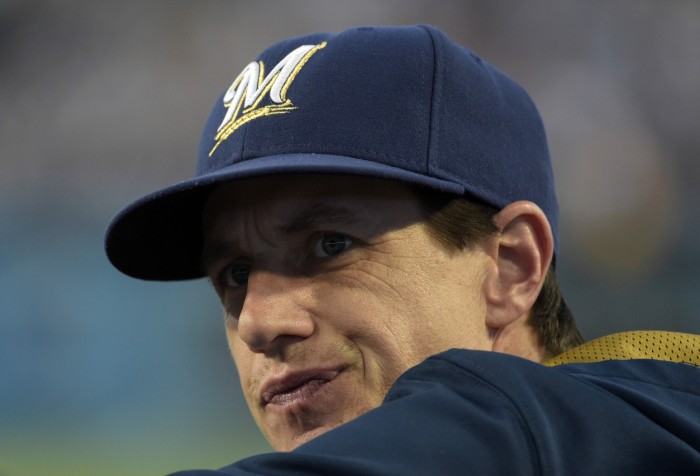The Brewers have brought in so many new faces this offseason, it’s hard to keep track of them all. On one day in December alone, they claimed three players on waivers: outfielder Kirk Nieuwenhuis, ostensibly-a-catcher Josmil Pinto, and first baseman Andy Wilkins. Pinto and Wilkins don’t have much experience — combined, they’ve accumulated 325 big-league plate appearances. Nieuwenhuis, on the other hand, has 693 plate appearances over four seasons, making him something of a known quantity. What will the 28-year-old bring to the Brewers in 2016 (if he stays on the team)?
We should first draw a distinction between past and future accomplishments. Right now, Nieuwenhuis has 2.4 career WARP to his name, making him about an average player. fWAR and rWAR feel the same way, pegging his performance at 2.5 and 2.4 wins, respectively. But that optimism doesn’t carry over to the coming season, as both PECOTA (0.3 WARP in 442 plate appearances) and the FanGraphs depth charts (0.5 fWAR in 331 plate appearances) project a drop-off.
The main cause for concern with Nieuwenhuis, as with many fringe players, is his tendency to strikeout. Opponents have fanned him in 31.5 percent of his plate appearances; among National League hitters with at least 600 plate appearances since 2012, only Drew Stubbs and Jarrod Saltalamacchia have gone down on strikes more frequently. Nieuwenhuis has the rare and undesirable call/whiff combination: Per Baseball-Reference, he’s taken a looking strike 19.4 percent of the time and a swinging strike 13.8 percent of the time, compared to respective major-league averages of 17.5 and 10.4 percent. Even with some positive regression aiding his case, PECOTA expects this trend to continue, projecting a strikeout rate of 28.7 percent.
On the other side of the plate-discipline equation, Nieuwenhuis has fared a little better. He’s walked in 9.1 percent of his chances, which has helped him reach base at a respectable .306 clip despite a .232 batting average. An O-Swing rate of only 27.6 percent has brought him those free passes, albeit at the cost of some looking strikes (he’s also posted a 59.4 percent Z-Swing rate). PECOTA predicts Nieuwenhuis will maintain that patient approach, projecting an 8.6 percent walk rate that would fit right in with his new team.
So if PECOTA thinks Nieuwenhuis will improve with regards to strikeouts and stay the same in terms of walks, why does it foresee a decline overall? That comes down to contact. Nieuwenhuis owns a career ISO of .157 and a BABIP of .326. With most of his playing time occurring in pitcher-friendly stadiums — he has a career batter park factor of 96 — those marks look pretty good. They’ve provided most of the support for his lifetime TAv of .261, a marginally above-average level of offense.
PECOTA projects a similar .184 ISO, around what we might suspect, given the shallow dimensions of Miller Park. When it comes to Nieuwenhuis’s BABIP, though, things diverge from expectations. Balls in play will theoretically create Nieuwenhuis’s struggles, as PECOTA thinks he’ll plummet to .298 in that regard. Nieuwenhuis has consistently made solid contact to this point, with a 32.4 percent hard-hit rate and just 4.4 percent popups. Then again, BABIP generally trends downward with age, and with a lifetime BRR of -0.3, Nieuwenhuis doesn’t have much speed to fall back on. The forecast here seems right, meaning the .250 PECOTA TAv has a good shot of happening.
There’s also the matter of defense, which has never been an especially great area for Nieuwenhuis — across 1,308.0 innings in the outfield, he’s earned 4.1 FRAA. PECOTA still thinks he’ll fall off in 2016, predicting a -4-run performance. The aforementioned lack of speed will likely be the culprit here as well, along with the fact that Nieuwenhuis will man center for Milwaukee. Together with his uninspiring offense, this doesn’t paint an appetizing picture.
With all of that said, Nieuwenhuis has some upside. Just two years ago, he pounded out a .306 TAv and 1.0 WARP over a mere 130 plate appearances. The odds of him repeating that seem pretty slim; it would realistically make the Brewers happy if he produced at even an average level. Waiver claims don’t usually amount to anything, the Jose Bautistas of the world notwithstanding, and desiring anything notable from a free-swinging, BABIP- and defense-losing outfielder will lead to disappointment.

If all goes well I believe Nieuwenhuis can be a jewel for the Brewers. Don’t know where you have come up with this he is slow stuff. He steals bases, takes the extra base and runs down most long balls in the out and slides well to made the catch.